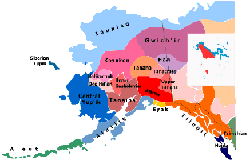
On Tuesday, February 19th, I had the opportunity to sit down with Dr. Michael Krauss at his home in Fairbanks, AK to have a conversation about the Alaska Native Peoples and Languages map. Having flown up from Anchorage for only the day, I returned with nearly five hours in audio recordings. Together with ANLC's Gary Holton, ISER staff assembled a list of questions that center on Dr. Krauss' early motivators for making the map and the methodologies that he employed in doing so. Having himself never written down the processes or challenges that he faced in creating the map, Dr. Krauss was incredibly cooperative and we are thankful to him for volunteering his time.
ISER plans on transcribing the interview and then publishing it on Alaskool with audio excerpts. We are also interested in publishing a summary of the relevant information garnered from the interview in an explanatory booklet that would accompany the revised map, still in draft form.
Aside from describing his early interest in Alaska Native languages, Dr. Krauss also talked about the map's political undertones and the message that he hoped it would convey. He also spoke to the empowering qualities of Native languages, both literally and figuratively, and the decisions that Native people confronted with language loss inevitably have to make.
Below are a handful of the questions addressed in the interview:
- What was your motivation for mapping languages in Alaska and Canada?
- How did you measure the number of current speakers within any village, and how did those methodologies change from one village to the next?
- In your view, how can Alaska Native communities most effectively revitalize their languages?
- Why did you determine the boundaries between languages, especially in places where there are few communities?
- The Map shows 20 languages, while previous maps showed fewer. Would a diffeerent number be equally plausible / possible?

No comments:
Post a Comment